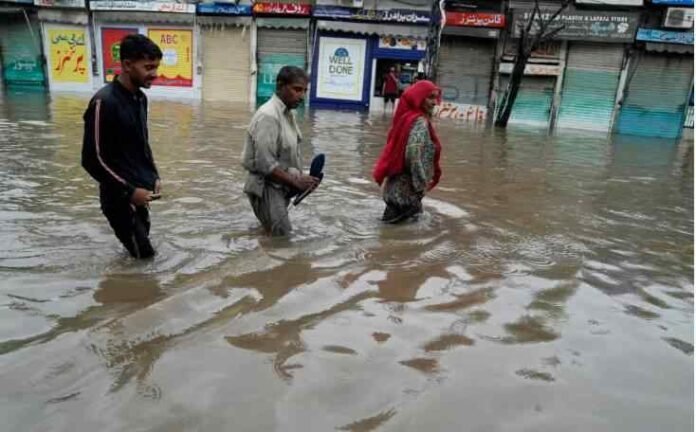Contents
Rawalpindi – Another round of intense monsoon rains is expected to hit large parts of Pakistan starting August 29, with downpours forecast to continue through September 2, according to the Pakistan Meteorological Department (PMD).
The new weather system is being fueled by strong monsoon currents entering from both the Arabian Sea and Bay of Bengal, while a westerly wave is expected to further intensify rainfall over northern and central regions.
Kashmir, Gilgit-Baltistan, and Khyber Pakhtunkhwa in the Firing Line
Heavy rain, thunderstorms, and possible cloudbursts are predicted in Kashmir’s Neelum Valley, Muzaffarabad, Rawalakot, Kotli, Bhimber, and Mirpur throughout the forecast period. The mountain districts of Gilgit-Baltistan—including Diamer, Astore, Hunza, Skardu, and Ghizer—are also expected to receive intermittent but at times heavy showers from August 30 to September 1.
In Khyber Pakhtunkhwa, nearly all districts—from Chitral and Swat down to Dera Ismail Khan—are on alert for heavy rainfall, with authorities warning of potential landslides in vulnerable areas.
Punjab Faces Renewed Threat as Floods Persist
Much of Punjab, already battling devastating floods in several districts, is bracing for more intense rain over the next five days. Cities including Lahore, Faisalabad, Gujranwala, Sialkot, Rawalpindi, and Multan are all expected to see heavy rainfall.
Southern districts such as Dera Ghazi Khan, Rajanpur, and Rahim Yar Khan are also likely to be affected, raising concerns of worsening riverine and flash floods.
Sindh and Balochistan to See Scattered Downpours
The PMD expects Sindh’s Tharparkar, Umerkot, Larkana, and Sukkur districts to receive rainfall between August 30 and 31, while parts of Balochistan, including Khuzdar, Zhob, Barkhan, and Loralai, could see storms and isolated heavy showers from August 30 to September 1.
Flooding, Landslides, and Urban Chaos Expected
Meteorologists have issued multiple warnings:
- Flash Flood Risk: Likely in hilly areas of Kashmir, Punjab, and KP.
- Landslides: Expected in mountainous regions such as Murree, Galiyat, KP, and Gilgit-Baltistan, which could lead to road closures.
- Urban Flooding: Major cities, including Islamabad, Lahore, Rawalpindi, Peshawar, Gujranwala, Sialkot, Faisalabad, Nowshera, and Mardan, are on high alert for waterlogging and infrastructure strain.
A Familiar Pattern, but Growing Intensity
This latest system follows weeks of relentless monsoon activity that has already triggered floods across Punjab and Sindh, damaging crops and infrastructure. Meteorologists warn that the back-to-back systems reflect a strengthening monsoon cycle this year, with moisture-laden winds from both the Arabian Sea and Bay of Bengal converging over Pakistan.
Authorities are urging residents in flood-prone areas to stay alert and avoid unnecessary travel during heavy downpours.


